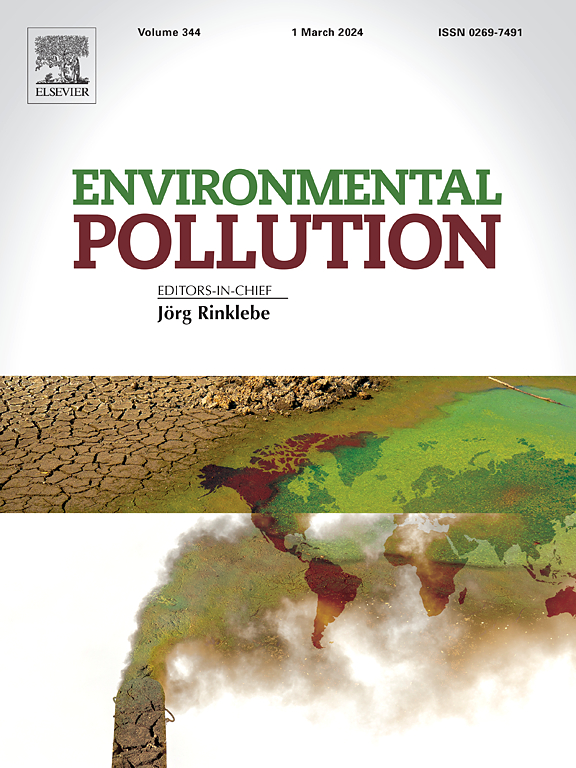环境臭氧与怀孕时间的关系以及环境温度的调节作用:一项基于人群的队列研究
IF 7.6
2区 环境科学与生态学
Q1 ENVIRONMENTAL SCIENCES
引用次数: 0
摘要
关于臭氧(O3)对生育能力影响的研究尚无定论,缺乏证据来检验臭氧暴露和温度变化的滞后模式。目前的研究主要在北美和欧洲进行,对亚洲人口的研究存在空白。这项以人群为基础的前瞻性队列研究涉及中国云南省594,110对夫妇,他们参加了国家免费孕前健康检查项目。根据每个女性的月经周期长度和居住地址,我们计算了怀孕前1-12个月经周期的周期特异性O3浓度随时间变化的情况。怀孕时间被用作结果指标。采用离散时间Cox回归模型结合分布滞后模型(DLM)进行分析。我们观察到,臭氧暴露与生育能力呈负相关,随着受孕时间的推移,这种影响逐渐减弱。孕前第一个月经周期对O3暴露最敏感,下降6.2% (HR: 0.938;95% CI: 0.936 ~ 0.941), O3每增加1 IQR可育性。同时暴露于O3和环境温度可能会产生协同效应。温度的调节作用在受孕前第一个周期最为明显,低温、中位和高温条件下的hr分别为0.891 (95% CI: 0.886 ~ 0.895)、0.859 (95% CI: 0.853 ~ 0.865)和0.833 (95% CI: 0.826 ~ 0.840)。需要有针对性的政策干预来减轻空气污染和气温上升的双重影响。本文章由计算机程序翻译,如有差异,请以英文原文为准。


Association of ambient ozone with time to pregnancy and the modifying effect of ambient temperature: a population-based cohort study
Research on the impact of ozone (O3) on fecundability has been inconclusive, lacking evidence examining the lagged pattern of ozone exposure and temperature modification. Current studies have predominantly been conducted in North America and Europe, leaving a gap in research from the Asian population. This population-based prospective cohort study involved 594,110 couples in Yunnan Province, China, enrolled in the National Free Preconception Health Examination Project. We calculated time-varying cycle-specific O3 concentration across 1–12 menstrual cycles before conception, according to each female's menstrual cycle length and residential addresses. Time to pregnancy was used as an outcome indicator. A discrete-time Cox regression model integrated with a distributed lag model (DLM) was employed for analysis. We observed that O3 exposure was negatively associated with fecundability, with the effect diminishing over time relative to conception. The first menstrual cycle before conception appeared most sensitive to O3 exposure, showing a 6.2 % decrease (HR: 0.938; 95 % CI: 0.936 to 0.941) in fecundability per one IQR increase of O3. Combined exposure to O3 and ambient temperature may exert a synergistic effect. The modifying effect of temperature was most pronounced in the first cycle before conception, with HRs of 0.891 (95 % CI: 0.886 to 0.895), 0.859 (95 % CI: 0.853 to 0.865), and 0.833 (95 % CI: 0.826 to 0.840) under low-, median-, and high-temperature conditions, respectively. Targeted policy interventions are needed to mitigate the dual impact of air pollution and rising temperatures.
求助全文
通过发布文献求助,成功后即可免费获取论文全文。
去求助
来源期刊

Environmental Pollution
环境科学-环境科学
CiteScore
16.00
自引率
6.70%
发文量
2082
审稿时长
2.9 months
期刊介绍:
Environmental Pollution is an international peer-reviewed journal that publishes high-quality research papers and review articles covering all aspects of environmental pollution and its impacts on ecosystems and human health.
Subject areas include, but are not limited to:
• Sources and occurrences of pollutants that are clearly defined and measured in environmental compartments, food and food-related items, and human bodies;
• Interlinks between contaminant exposure and biological, ecological, and human health effects, including those of climate change;
• Contaminants of emerging concerns (including but not limited to antibiotic resistant microorganisms or genes, microplastics/nanoplastics, electronic wastes, light, and noise) and/or their biological, ecological, or human health effects;
• Laboratory and field studies on the remediation/mitigation of environmental pollution via new techniques and with clear links to biological, ecological, or human health effects;
• Modeling of pollution processes, patterns, or trends that is of clear environmental and/or human health interest;
• New techniques that measure and examine environmental occurrences, transport, behavior, and effects of pollutants within the environment or the laboratory, provided that they can be clearly used to address problems within regional or global environmental compartments.
 求助内容:
求助内容: 应助结果提醒方式:
应助结果提醒方式:


